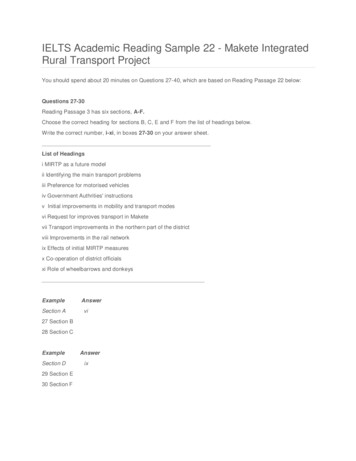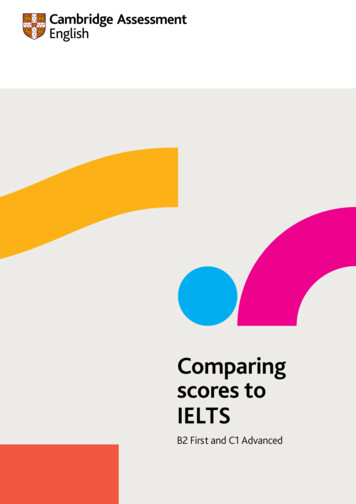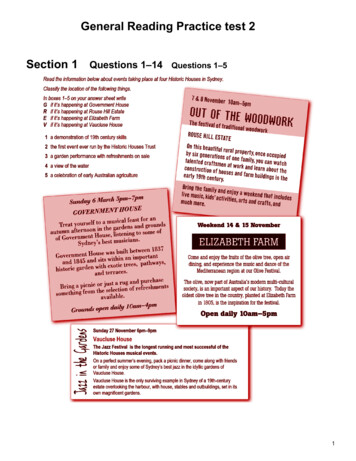
Transcription
IELTS Academic Reading Sample 12 - The Nature andAims of ArchaeologyYou should spend about 20 minutes on Questions 28-40. which are based on Reading Passage 12.The Nature and Aims of ArchaeologyArchaeology is partly the discovery of treasures of the past, partly the work of the scientific analyst, partly theexercise of the creative imagination. It is toiling in the sun on an excavation in the Middle East, it is working withliving Inuit in the snows of Alaska, and it is investigating the sewers of Roman Britain. But it is also thepainstaking task of interpretation, so that we come to understand what these things mean for the human story.And it is the conservation of the world’s cultural heritage against looting and careless harm.Archaeology, then, is both a physical activity out in the field, and an intellectual pursuit in the study orlaboratory. That is part of its great attraction. The rich mixture of danger and detective work has also made itthe perfect vehicle for fiction writers and film-makers, from Agatha Christie with Murder in Mesopotamia toStephen Spielberg with Indiana Jones. However far from reality such portrayals are, they capture the essentialtruth that archaeology is an exciting quest – the quest for knowledge about ourselves and our past.But how does archaeology relate to other disciplines such as anthropology and history that are also concernedwith the human story? Is archaeology itself a science? And what are the responsibilities of the archaeologist intoday’s world?Anthropology, at its broadest, is the study of humanity- our physical characteristics as animals and our uniquenon-biological characteristics that we call culture. Culture in this sense includes what the anthropologist,Edward Tylor, summarised in 1871 as ‘knowledge, beliefs, art, morals, custom and any other capabilities andhabits acquired by man as a member of society’. Anthropologists also use the term ‘culture’ in a more restrictedsense when they refer to the ‘culture’ of a particular society, meaning the non-biological characteristics uniqueto that society, which distinguish it from other societies. Anthropology is thus a broad discipline – so broad thatit is generally broken down into three smaller disciplines: physical anthropology, cultural anthropology andarchaeology.Physical anthropology, or biological anthropology as it is called, concerns the study of human biological orphysical characteristics and how they evolved. Cultural anthropology – or social anthropology – analyseshuman culture and society. Two of its branches are ethnography (the study at first hand of individual living
cultures) and ethnology (which sets out to compare cultures using ethnographic evidence to derive generalprinciples about human society).Nevertheless, one of the most important tasks for the archaeologist today is to know how to interpret materialculture in human terms. How were those pots used? Why are some dwellings round and others square. Herethe methods of archaeology and ethnography overlap. Archaeologists in recent decades have developed‘ethnoarchaeology’ where, like ethnographers, they live among contemporary communities, but with thespecific purpose of learning how such societies use material culture – how they make their tools and weapons,why they build their settlements where they do, and so on. Moreover, archaeology has a role to play in the fieldof conservation. Heritage studies constitute a developing field, where it is realised that the world’s culturalheritage is a diminishing resource which holds different meanings for different people.If, then, archaeology deals with the past, in what way does it differ from history? In the broadest sense, just asarchaeology is an aspect of anthropology, so too is it a part of history – where we mean the whole history ofhumankind from its beginnings over three million years ago. Indeed, for more than ninety-nine percent of thathuge span of time, archaeology – the study of past material culture – is the only significant source ofinformation. Conventional historical sources begin only with the introduction of written records around 3,000 BCin western Asia, and much later in most other parts in the world.A commonly drawn distinction is between pre-history, i.e. the period before written records - and history in thenarrow sense, meaning the study of the past using written evidence. To archaeology, which studies all culturesand periods, whether with or without writing, the distinction between history and pre-history is a convenientdividing line that recognises the importance of the written word, but in no way lessens the importance of theuseful information contained in oral histories.Since the aim of archaeology is the understanding of humankind, it is a humanistic study, and since it dealswith the human past, it is a historical discipline. But is differs from the study of written history in a fundamentalway. The material the archaeologist finds does not tell us directly what to think. Historical records makestatements, offer opinions and pass judgements. The objects the archaeologists discover, on the other hand,tell us nothing directly in themselves. In this respect, the practice of the archaeologist is rather like that of thescientist, who collects data, conducts experiments, formulates a hypothesis tests the hypothesis against moredata, and then, in conclusion, devises a model that seems best to summarise the pattern observed in the data.The archaeologist has to develop a picture of the past, just as the scientist has to develop a coherent view ofthe natural world.
Questions 14-19Do the following statements agree with the claims of the writer in Reading Passage 164?In boxes 14-19 on your answer sheet write:YES if the statement agrees with the cliams of the writerNO if the statement contradicts the claims of the writerNOT GIVEN if it is impossible to say what the writer thinks about this14 Archaeology involves creativity as well as investigative work.15 Archaeologist must be able to translate texts from ancient languages.16 Movies give a realistic picture of the work of archaeologists.17 Anthropologist define culture in more than one way.18 Archaeology is a more demanding field of study than anthropology.19 The history of Europe has been documented since 3,000 BC.Questions 20 and 21Choose TWO letters A – EWrite your answer in boxes 20 and 21 on your answer sheet.The list below gives some statements about anthropology.Which TWO statements are mentioned by the writer of the text?A It is important for government planners.B It is a continually growing field of study.C It often involves long periods of fieldwork.D It is subdivided for study purposes.E It studies human evolutionary patterns.Questions 22and 23Choose TWO letters A – EWrite your answer in boxes 22 and 23 on your answer sheet.The list below gives some of the tasks of an archaeologist.Which TWO of these tasks are mentioned by the writer of the text?A examining ancient waste sites to investigate diet
B studying cave art to determine its significanceC deducing reasons for the shape of domestic buildingsD investigating the way different cultures make and use objectsE examining evidence for past climate changesQuestions 24-27Complete the summary of the last two paragraphs of Reading Passage 164.Choose NO MORE THAN TWO WORDS from the passage for each answer.Write your answer in boxes 24-27 on your answer sheet.Much of the work of archaeologists can be done using written records, but they find 24. equally valuable. The writer describes archaeology as both a 25 . anda 26 . However, as archaeologists do not try to influence human behaviour, the writer comparestheir style of working to that of a 27 .Answer:14 YES15 NOT GIVEN16 NO17 YES18 NOT GIVEN19 NO20 & 21 D, E (In either order)
22 & 23 C, D (In either order)24 oral histories24 & 26 humanistic study, historical discipline (In In either order)27 scientist
IELTS Academic Reading Sample 12 - The Nature and Aims of Archaeology You should spend about 20 minutes on Questions 28-40. which are based on Reading Passage 12. The Nature and Aims of Archaeology Archaeology is partly the discovery of treasures of the past, partly the work of the scientific analyst, partly the exercise of the creative .










